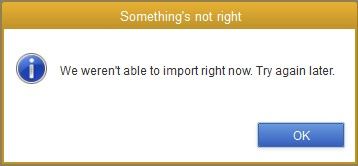Go through the blog, you’ll get a complete guideline related to IIF import fails in QuickBooks Desktop. Importing transactions and lists is pretty convenient and more accurate in QuickBooks Desktop with the IIF Tool. Sometimes, it happens when users encounter an error in the correct IIF format of their document.
Intuit Interchange Format (.IIF) files are usually used to import or export lists and to import transactions in QuickBooks Desktop. The .IIF files consist of TSV (Tab-Separated Value), and ASCII text files. These file types make it easier to transfer data from and to various platforms to better manage QuickBooks company records.
What is the Intuit Interchange Format (.IIF) Import Kit
It is easy to import and export .IIF files in QuickBooks Desktop because it offers features that automatically format the file with ease for you. However, creating .IIF files from scratch or converting data from another system is technically challenging and can be difficult if you don’t have experience coding delimited text files.
This makes it easier and faster to enter the information directly into QuickBooks Desktop unless you are required to import very large amounts of data. You can download and install .IIF import kit to continue Importing to save time and boost your performance. You can also download the sample to practice and easily use the template for importing QuickBooks transactions.
How to Troubleshoot IIF Import Fails in QuickBooks Desktop

To correct the IIF format of your document then you should have a kit with a formatted document. After that, you can only input the data and upload it later. Read the steps to troubleshoot IIF import fails in QuickBooks Desktop.
- You have to choose Review now.
- Then you have to look for the error to see what the problem with the file is.
- You have to correct the errors and then Save.
- Now you have to close the File not imported window.
- Then you have to Import the new, corrected .IIF file.
How to Save the IIF File and Import Easily
- You have to go to the File menu, then you have to select Utilities then you have to Import then IIF Files.
- Then you have to select Import IIF.
- Now you have to find the file, then you have to select OK.
- It is not suggested that the choice.
- Some of the information may not be correct or complete for your books because this option skips data review. You must also change to using a single user.
- When the import is successful, the number of lists and transactions imported will be displayed.
- Then you have to press Done.
Instructions to Download and Install .IIF Import Kit
The QuickBooks IIF import kit is a reference guide to building and working with import files from IIF. It includes the following components.
● IIF Import Manual: A .pdf document is nothing but that outlines common .iif pitfalls and best practices.
● IIF Example Files: Basically, a folder containing examples of version-specific .iif transactions.
● IIF Header Help: The headings for columns are used to import list data.
- Download .IIF import kit {DOWNLOAD KIT}.
- Next, click on the Save button to save the downloaded IIF_Import_Kit.zip file on your Windows desktop.
- Now use WinZip or any compatible file compression utility to extract the contents of the downloaded file.
- The contents are automatically extracted into a subfolder called .IIF Import Kit.
- To view its contents, open the IIF Import Kit folder.
Steps to Import Transactions IIF file QuickBooks Desktop
- Initially sign up as an Admin to your company file.
- Next, go to File and then Select the “Single-User Mode” option and switch to it.
- Taking a backup of a company file is important.
- This may help in the future if the data doesn’t import the way you expected.
- After that, select the File menu and then choose Utilities.
- Now select the Import option within Utilities and then select the option called “Import IIF Files”.
- Look for the IIF file then right-click on it to select the Open option.
- At last, hit the “OK” button to make sure that data is exported.
Lists you can Import
IFFs are used to import and export QuickBooks Desktop data. You can also import things such as bank transactions, general journal entries, accountant changes, and batch transactions. You can also import lists like your vendor and customer lists and details are listed below. Have a look:
- Vendor types
- Employees
- Items
- Import Chart of Accounts
- Sales tax codes
- Customers and Customer
- jobs
- Classes
- Customer messages
- Customer and job types
- Budgets
- Import Sales Receipt
- Price level
- Import Invoices into QuickBooks
- Shipping methods
- Payment terms
- Import Inventory in QuickBooks
When the file is imported then you can see the number of lists and transactions imported. Hopefully, the above-discussed information helps you to troubleshoot IIF Import fails in QuickBooks Desktop. In case, if you still have any questions about importing in QB or have any queries related to this. Feel free to connect with the QuickBooks error support toll-free help desk number. You can also reach them via dropping an email at [email protected] or doing a live chat with dedicated experts.
Frequently Asked Questions
When you import IIF files it doesn’t link transactions?
It doesn’t link transactions when you import IIF files. For example, after the import you still need to link an invoice and an invoice payment. Then you have to go to the Receive Payments or Pay Bills window to link transactions. To import and link transactions you can also use third-party apps.
Can an IIF file be imported into QuickBooks Online?
You can open the file by going to File and then Open Company, once you import the IIF file into QuickBooks. You have to select the import file in the Open Company window and then click Open. From QuickBooks to an IIF file you can also export data.
How to fix an IIF file in QuickBooks?
. Begin by making a copy of your IIF File and then you have to right-click on it and then Rename it.
. Change the Extension to XLSX for renaming it and then you have to open the File in Excel.
. Now you can go to the IIF Line Error and then you have to correct it in QuickBooks.

